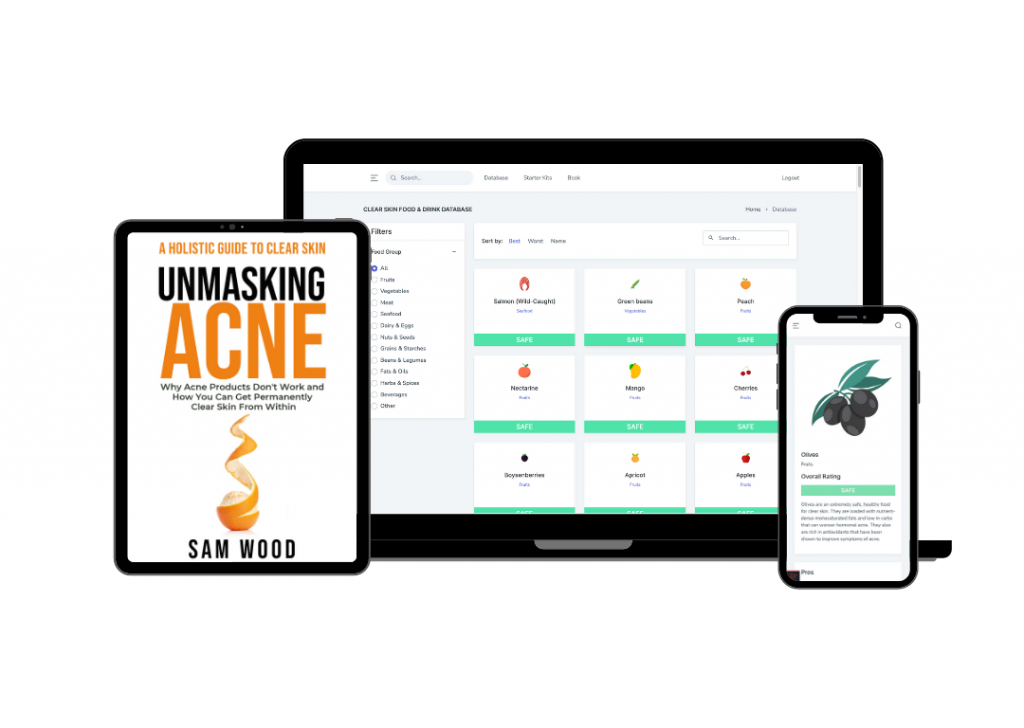Apple cider vinegar has long been lauded for a variety of health benefits including weight loss, a reduction in blood sugar levels, and improved gut health.
However, over the last few years ACV has gained significant popularity as a natural remedy acne as well as numerous other skin and hair issues.
In this article, we’ll review the primary reasons why many people gravitate towards apple cider vinegar as an acne treatment including it antibacterial and anti-fungal properties, its ability to exfoliate the skin, tighten the pores, and alter the skin’s pH level.
Additionally, we’ll cover some of the most common side effects of ACV use, provide recommended guidelines for safely using ACV, and finally share our preferred alternatives to treating acne breakouts.
1. Apple cider vinegar is antibacterial
Apple cider vinegar has antimicrobial properties due to its acidic nature, which can help eliminate bacteria and dirt on the skin’s surface.
Acne causing bacteria (Cutibacterium acnes) typically prefer a low oxygen and neutral or slightly acidic environment, but they can’t survive in a too acidic environment apple cider vinegar creates.
It’s important to note that this acidic environment can also kill helpful bacteria which protect the skin barrier and aid in hydration.
2. Apple cider vinegar is exfoliating
Apple cider vinegar contains alpha hydroxy acids acids that act as natural exfoliants, helping dissolve and shed the proteins holding dead skin cells. This leaves the skin looking clearer, brighter, and more uniform complexion underneath all the buildup.
Specifically, the acids Lactococcus and Oenococcus, which develop during the fermentation process and are high in lactic acid and malic acid help to clear out dirt and oils that provide a breeding ground for acne-causing bacteria.
3. Apple cider vinegar is anti-fungal
Apple cider vinegar is a scientifically proven antifungal, due to its high acetic acid content that destroys the cell membrane of most fungi, including malassezia yeast.
Additionally, laboratory research shows that ACV can inhibit the growth of candida cultivating in a petri dish, which is a common type of fungal infection in the nails.
4. Apple cider vinegar is an astringent
Apple cider vinegar’s acidic and exfoliation properties cause the pores to tighten due to protein denaturation, tissue contraction, and the removal of oils
- Protein Denaturation: When astringents are applied to the skin, they can denature (or coagulate) the proteins on the skin’s surface. This denaturation causes the proteins to tighten or contract.
- Tissue Contraction: The action of astringents causes the skin tissues to contract. This can temporarily make the skin appear firmer and can reduce the appearance of pores.
- Removal of Oils: Astringents can strip the skin of its natural oils. Oftentimes, clogged pores are “swollen” with outside bacteria, so clearing them out allows to “tighten once emptied.
5. ACV has a low PH
Apple cider vinegar has an acidity level of 2-3, which makes it difficult for acne causing bacteria to grow and spread. Normal skin has pH level 4.5-5.5 and the higher the pH level of the skin becomes, the easier it is for acne to develop.
By lowering the skin’s pH, apple cider vinegar can help restore the balance of good bacteria in the skin and prevent the growth of harmful bacteria. This can help reduce inflammation and irritation caused by both bacterial overgrowth and chemical imbalances in the skin.
It’s important to keep in mind that if the skin’s pH is too low helpful, natural oils will be stripped from the skin which will cause peeling, dryness, and itchiness of the skin.
Health risks of using apple cider vinegar
There are several nasty side effects that come from using apple cider vinegar improperly or too frequently, despite the above mentioned properties that make it an appealing candidate for treating acne breakouts at home. Below we have listed a few common risks of prolonged use of apple cider vinegar (all of which have to do with its acidity content):
1. Tooth enamel decay
Chugging large amounts of apple cider vinegar can be detrimental to your teeth, due to its acidic levels.
Over time, this will give your teeth a yellowish tinge, and increase dental sensitivity for both cold and hot foods.
If you decide to drink apple cider vinegar as a supplement and you should dilute it with water and immediately brush your teeth.
2. Esophagus Irritation & Digestive Tract Issues
Apple cider vinegar is highly acidic, and consuming large amounts of it can lead to irritation in the esophagus and cause pain at the substernal and epigastric areas as well as gut soreness, tenderness, vomiting, and hematemesis, or the vomiting of blood.
Because of this, you should dilute ACV with water and start with a small amount before taking a “full dosage”.
3. Skin irritation & dryness
Apple cider vinegar can cause excessively dry skin and burns due to its high acidic content. Apple cider vinegar’s acidic content is a double edged sword. The acidity content is the primary reason apple cider vinegar is an effective treatment for acne, but when used it excess it can strip the skin of beneficial oils and bacteria. Because of this its recommended that ACV is used sparing in any skincare routine.
4. Sun Sensitivity
Topical apple cider vinegar application increases sun sensitivity in the skin because it cleans out the pores and causes the skin to shed.
While the majority of the shedding contains dead skin cells ACV will cause some “live cells” to slough off as well bringing fresh skin to the surface. This “fresh skin” will likely be sensisitve for 24-48 hours so you should limit time in the sun and use a non-comedogenic sunscreen.
Can apple cider vinegar help balance hormones?
There is no definitive evidence that apple cider vinegar can help with hormonal regulation. There are anecdotal reports of ACV helping to alleviate symptoms of PCOS, but more research is needed before
Is it better to drink ACV or apply it topically for treating acne?
When it comes to acne breakouts, you are likely to see a more direct effect from a topical application of ACV mixed with water vs. ingesting a supplement or drinking it outright.
It’s important to note that will apple cider vinegar can help clear oil and debris out of the pores it is not a good long term option for treating acne breakouts.
Can Apple Cider Vinegar be Applied Directly to The Skin?
Apple cider vinegar can be strong when applied directly to the skin due to its low pH value and acidic nature that will instantly bring the skin’s pH to be much lower, which could cause burning and irritation.
That is why it should always be diluted in water and sometimes mixed with other soothing and healing herbs like chamomile, green tea, or rosemary extract to help reduce the strength of the vinegar and prevent adverse side effects.
How To Make a DIY Apple Cider Vinegar Toner
The best way to make a DIY apple cider vinegar toner is to mix one part apple cider vinegar and two parts distilled or filtered water to help reduce the acidity. Below we have included a step by step process for both creating and using a DIY ACV toner with minimal issues:
- Determine Skin Sensitivity:
- If you’re new to using ACV on your skin, it’s best to start with a more diluted solution to gauge how your skin reacts.
- Mixing Ratios:
- For Sensitive Skin: Mix 1 part ACV with 4 parts water.
- For Normal/Dry Skin: Mix 1 part ACV with 2 parts water.
- For Oily Skin: Mix 1 part ACV with 1 part water.
- Preparation:
- In a clean glass or plastic bottle, combine the ACV with distilled or purified water according to the ratio that best suits your skin type.
- Application:
- After cleansing your face, dampen a cotton pad with the ACV toner.
- Gently swipe the cotton pad across your face, avoiding the eye area.
- Let the toner air dry on your skin.
- Moisturize:
- Once the toner has dried, follow up with a non-comedogenic moisturizer to keep your skin hydrated.
- Storage:
- Store your DIY ACV toner in a cool, dark place. If you’ve made a large batch, consider storing it in the refrigerator to prolong its shelf life.
- Patch Test:
- Before using the toner on your entire face, it’s recommended to do a patch test on a small area of skin (like behind your ear) to ensure you don’t have any adverse reactions.
- Usage:
- Use the toner once or twice daily. If you notice any dryness or irritation, reduce the frequency of use or adjust the dilution ratio.
What are the other health benefits of apple cider vinegar?
Although this article primarily analyzed the skin benefits of apple cider vinegar, there are numerous purported health benefits of supplementing with ACV which we have shared below:
- Blood Sugar Regulation: Consuming ACV may help improve insulin sensitivity and reduce blood sugar spikes, especially after eating. This has made it a popular remedy among those looking to manage type 2 diabetes or prediabetes.
- Improves Nutrient Absorption: The acetic acid in ACV can enhance the body’s absorption of important minerals from the diet, such as calcium. This makes nutrients more available for the body to use.
- Supports Healthy Lymphatic System: ACV can assist in breaking up mucus throughout the body and cleansing the lymph nodes. This might support better lymph circulation and boost the immune system.
- Cardiovascular Health: Research indicates that ACV might help lower cholesterol and triglyceride levels, both of which are cardiovascular disease risk factors. However, most of these studies have been conducted on animals, and more human research is needed.
Although apple cider vinegar has many potential health benefits all of the conditions listed above should be discussed with a medical professional such as an endocrinologist, nutritionist, or cardiologist. It’s important to remember that ACV can serve as a “supplement” to help these conditions but is rarely the primary treatment agent
Is Apple Cider Vinegar The Best Way to Treat Acne?
Apple cider vinegar is not the best way to treat acne, as the side effects like skin irritation and burns, become increasingly more likely with frequent use.
Apple cider vinegar is a popular choice because of its easy accessibility and low cost. However, there are better options for long term skin health which we will discuss below.
What are the best alternatives to apple cider vinegar for acne?
The best alternative to apple cider vinegar for treating acne breakouts is to follow a healthy, low inflammation diet, exercise regularly, use non-comedogenic skincare products, and change your pillow case regularly. Below we have some more in-depth recommendations for treating acne breakouts without taking antibiotics or using expensive, skin stripping cosmetic products:
- Check all the products that come in contact with your skin and face in this acne safe ingredient checker
- Avoid inflammation cause foods like dairy, sugary foods, alcohol, and fried foods. I wrote a book on the best diets for clearing acne here.
- Change your pillow case at least twice a week and your sheets once a week, so you do not have oil buildup continually rubbing against your pores. We recommend using silk pillow cases because they absorb less oil.

